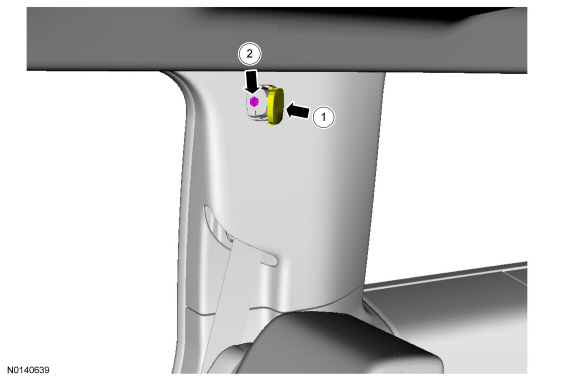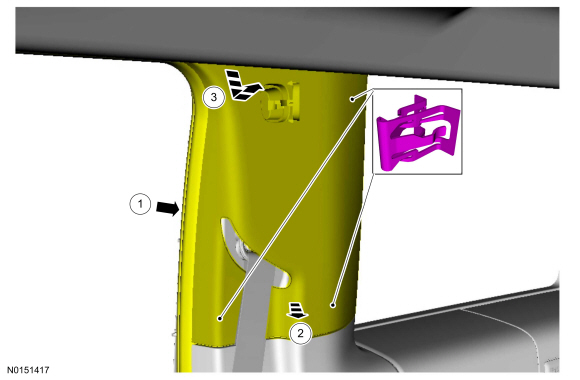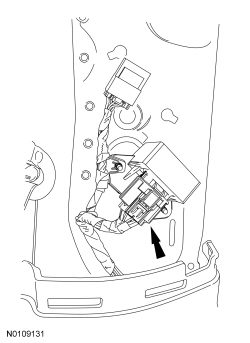SECTION 310-00: Fuel System — General Information
| 2014 Flex Workshop Manual
|
GENERAL PROCEDURES
| Procedure revision date: 05/02/2013
|
Fuel System Pressure Release
 WARNING: Do not smoke, carry lighted tobacco or have an open flame of any type when working on or near any fuel-related component. Highly flammable mixtures are always present and may be ignited. Failure to follow these instructions may result in serious personal injury.
WARNING: Do not smoke, carry lighted tobacco or have an open flame of any type when working on or near any fuel-related component. Highly flammable mixtures are always present and may be ignited. Failure to follow these instructions may result in serious personal injury.
 WARNING: Do not carry personal electronic devices such as cell phones, pagers or audio equipment of any type when working on or near any fuel-related component. Highly flammable mixtures are always present and may be ignited. Failure to follow these instructions may result in serious personal injury.
WARNING: Do not carry personal electronic devices such as cell phones, pagers or audio equipment of any type when working on or near any fuel-related component. Highly flammable mixtures are always present and may be ignited. Failure to follow these instructions may result in serious personal injury.
 WARNING: Before working on or disconnecting any of the fuel tubes or fuel system components, relieve the fuel system pressure to prevent accidental spraying of fuel. Fuel in the fuel system remains under high pressure, even when the engine is not running. Failure to follow this instruction may result in serious personal injury.
WARNING: Before working on or disconnecting any of the fuel tubes or fuel system components, relieve the fuel system pressure to prevent accidental spraying of fuel. Fuel in the fuel system remains under high pressure, even when the engine is not running. Failure to follow this instruction may result in serious personal injury.
 WARNING: When handling fuel, always observe fuel handling precautions and be prepared in the event of fuel spillage. Spilled fuel may be ignited by hot vehicle components or other ignition sources. Failure to follow these instructions may result in serious personal injury.
WARNING: When handling fuel, always observe fuel handling precautions and be prepared in the event of fuel spillage. Spilled fuel may be ignited by hot vehicle components or other ignition sources. Failure to follow these instructions may result in serious personal injury.
All vehicles
- Open the cover and remove the RH C-pillar trim panel retainer.
- Position the upper RH C-pillar trim panel aside.
- Disconnect the Fuel Pump (FP) control module electrical connector.
- Start the engine and allow it to idle until it stalls.
Gasoline Turbocharged Direct Injection (GTDI) equipped vehicles
NOTE:
On vehicles equipped with Gasoline Turbocharged Direct Injection (GTDI), it is necessary to release the high pressure fuel system prior to disconnecting a low pressure fuel tube quick connect coupling.
NOTE:
To release the fuel pressure in the high pressure fuel tube, wrap the flare nut with a shop towel to absorb any residual fuel pressure during the loosening of the flare nut.
Disconnect the high pressure fuel tube-to-fuel injection pump flare nut to release the pressure.
- Connect the high pressure fuel tube-to-fuel injection pump flare nut.
- Tighten to 30 Nm (22 lb-ft).
All vehicles
- Turn the ignition switch to the OFF position.
- When the fuel system service is complete, reconnect the
control module electrical connector.
- Position the upper RH C-pillar trim panel back.
- Install RH C-pillar trim retainer and close the cover.
NOTE:
It may take more than one key cycle to pressurize the fuel system.
Cycle the ignition and wait 3 seconds to pressurize the fuel system.
NOTE:
Carry out a Key ON Engine OFF (KOEO) visual inspection for fuel leaks prior to starting the engine.
Start the engine and check for leaks.
 WARNING: Do not smoke, carry lighted tobacco or have an open flame of any type when working on or near any fuel-related component. Highly flammable mixtures are always present and may be ignited. Failure to follow these instructions may result in serious personal injury.
WARNING: Do not smoke, carry lighted tobacco or have an open flame of any type when working on or near any fuel-related component. Highly flammable mixtures are always present and may be ignited. Failure to follow these instructions may result in serious personal injury.


